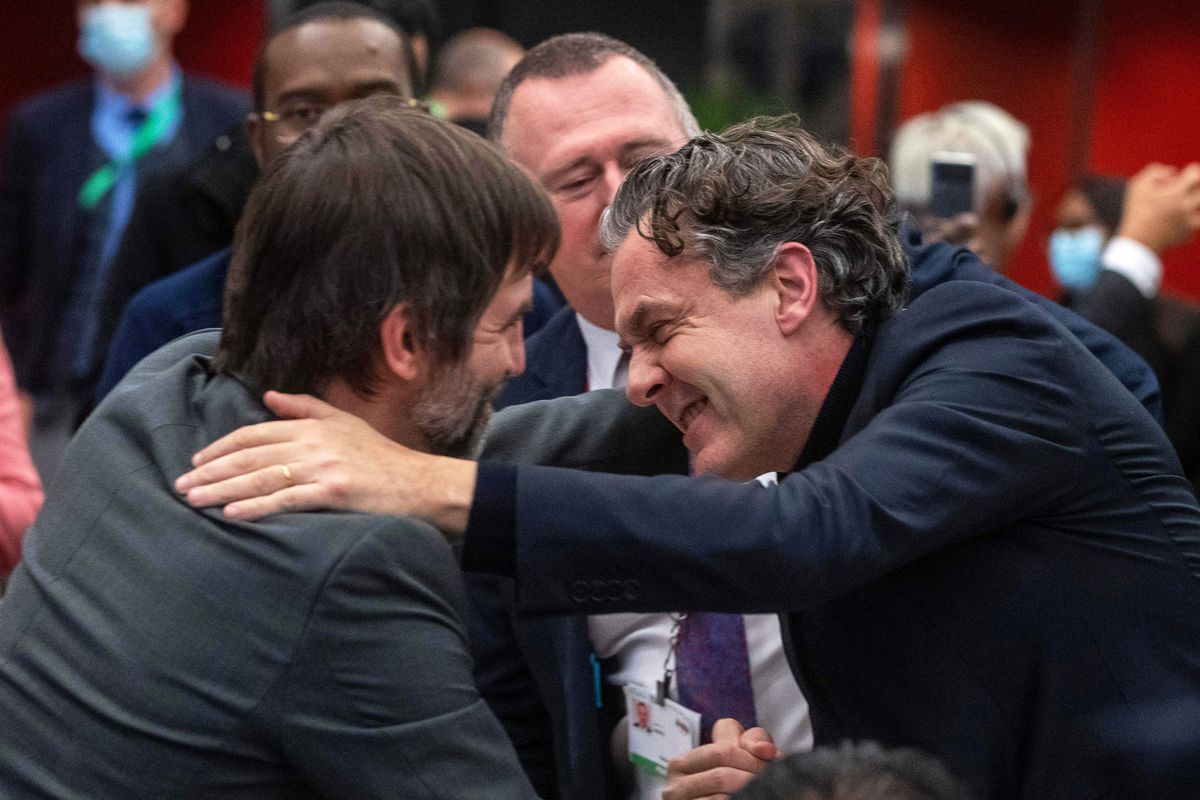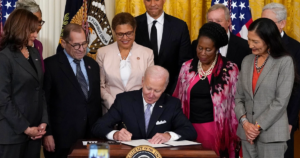At the UN Biodiversity Conference in Montreal, world leaders agreed to a historic plan to halt biodiversity loss.
By Benji Jones
MONTREAL, Canada — Early Monday morning, after several days of fraught negotiations, roughly 190 countries agreed on a historic plan to halt the decline of wildlife and ecosystems.
Adopted at a UN biodiversity conference called COP15, the agreement contains 23 targets that countries must achieve within the decade. They include conserving at least 30 percent of all land and water on Earth by 2030 — the largest land and ocean conservation commitment in history — and shrinking subsidies for activities that harm nature, such as industrial fishing.
The agreement, known as the Kunming-Montreal Global Biodiversity Framework, also commits rich countries to pay developing nations $30 billion a year by 2030 for conservation. That’s roughly a tripling of existing aid.
Environmental advocates say that this agreement could be our last chance to reverse the decline of nature. Ecosystems and the services they provide, such as pollination for food crops, are vanishing, as companies and governments bulldoze forests and prairies, and warm the Earth with greenhouse gases. One million species are now at risk of extinction and many wildlife populations have, on average, declined by nearly 70 percent in the last 50 years.
“The figures are terrifying,” Marco Lambertini, director general of WWF International, the world’s largest environmental organization, told Vox. “We’ve lost almost half of the forests, half of the coral reefs. It’s really, really bad.”
Biodiversity talks, like COP15, tend to draw far less attention than the big climate conferences — less than, say, COP27 in Egypt. Only a couple of heads of state showed up in Montreal and there were no A or B-list celebrities. Yet the agreement the conference produced is groundbreaking with wide-ranging implications for corporations, financial institutes, and governments.
“We have taken a great step forward in history today,” Steven Guilbeault, Canada’s minister of environment and climate change, said after the agreement was adopted, adding that COP15 is the most significant UN conference on biodiversity in history.
Now, attention turns to the question of whether nations will actually be able to achieve all 23 of the targets by the eight-year deadline, and what happens if they don’t. Unlike the Paris Agreement, the new biodiversity framework is not legally binding.
Here’s what you need to know about the landmark deal.
Countries agreed to nearly two dozen targets including conserving at least 30 percent of Earth within the decade
First, some quick lingo: COP15 is a meeting of countries that are members of a UN treaty called the Convention on Biological Diversity, or CBD. You can think of CBD as a contract, or agreement, between member countries to collectively sustain biodiversity (ecosystems, wildlife, and genetic diversity) and its benefits. Every country other than the Vatican is a member of the treaty — except the US.
These meetings can be chaotic and incredibly hard to follow, and they’re often overlooked by mainstream media. But this year’s event was slightly different because of a document at its center: the global biodiversity framework.
One key distinction between the framework and the Paris agreement is its complexity and scale; the Paris agreement zeroed in on one goal — to limit global warming to below 1.5 degrees Celsius — whereas this text contains nearly two dozen objectives, including a target to conserve at least 30 percent of all land and water by 2030, known as 30 by 30.
Although more than 100 countries had already agreed to 30 by 30 before coming to Montreal, it was still a point of contention at COP15. For one, it wasn’t clear what would count as “conserved” land. Some Indigenous groups were also worried that expanding the footprint of protected areas might come at the expense of their land rights. (Historically, environmentalists have evicted Indigenous people from their traditional territories in the name of wildlife conservation.)
But in its final form, the agreement indicates that a handful of different kinds of land can count toward the 30 percent target, including formal protected areas (such as national parks) and, in some cases, Indigenous territories. The final agreement also explicitly acknowledges that countries must respect the rights of Indigenous groups as they seek to conserve more land.
“The text provides a strong basis for countries to walk hand-in-hand with Indigenous peoples in addressing the biodiversity crisis and in ensuring that the negative legacy of conservation on Indigenous peoples will be corrected,” Jennifer Corpuz, a Filipino Indigenous lawyer and key negotiator for the International Indigenous Forum on Biodiversity, said in a statement Monday.
Another key target of the agreement commits countries to require large companies to disclose their environmental impacts and how dependent their profits are on ecosystems. For example, a large company that sells cacao might have to reveal how its farms impact forests and how the decline of pollinators affects its supply of cacao.
The idea is that by giving investors and consumers more visibility into a company’s footprint and nature-related risks, money will eventually move away from businesses that damage ecosystems and toward those that help restore them, according to Eva Zabey, executive director of a coalition of companies and nonprofits called Business for Nature.
A handful of other targets in the new deal are also noteworthy. Target 2, for example, commits countries to restore at least 30 percent of degraded land and water, such as prairie that was formerly farmland, whereas Target 10 calls on countries to make sure farmland, fisheries, and other productive areas are managed sustainably. Two of the targets also support nature-based solutions, a loosely defined buzzword meaning actions that help restore or conserve ecosystems while also benefitting human lives. (Regrowing coral reefs to help control coastal flooding during hurricanes is a great example.)
Arguably, however, the most important part of the framework — and its most controversial target — is about money.
The question that almost derailed the talks: Who pays for conservation?
A number you’d hear often in the halls and meeting rooms at COP15 was $700 billion.
That’s a rough estimate of the total gap in funding for biodiversity conservation worldwide, according to a widely cited report published in 2020. The report found that adequately conserving nature will cost, on average, about $844 billion a year by 2030, yet the world currently spends only a fraction of that. It costs money to set up and manage protected areas, make agriculture more sustainable, and so on.
Much of the air at COP15 was sucked up by discussions on closing that financial gap. They centered around three tense issues:
1) How much money will the world commit, in total, to biodiversity conservation each year?
2) How much of that money will wealthy nations give to developing countries?
3) Who will manage and distribute the money?
Negotiations reached a tipping point last week when delegates from developing countries including Brazil, India, and Indonesia walked out of finance talks after reaching an impasse with rich nations. “Financing is always the achilles’ heel of every global agreement,” Florian Titze, a policy advisor at WWF Germany, said at a press conference earlier this month.
By early Monday morning, however, delegates had struck a deal: In the new framework, they commit to spending $200 billion per year on conservation by the end of the decade, which will include public, private, and philanthropic support. It’s a huge sum, yet still only dents the massive finance gap.
Importantly, that money includes $20 billion in annual aid from rich nations to developing countries — which harbor most of the world’s remaining biodiversity — by 2025. The number increases to $30 billion a year by 2030.
The framework not only funnels money into conservation but aims to redirect government funds away from activities that harm nature. Countries spend as much as $1.8 trillion on subsidies that damage ecosystems, including those for fossil fuels, according to one 2022 study. Under one of the framework’s targets, countries pledged to identify harmful subsidies by 2025 and then, by 2030, shrink them by at least $500 billion a year.
These financial commitments are still unlikely to be sufficient to meet the goals of the framework, said John Tobin, a professor of finance at Cornell University (who coauthored the report that identified the $700 billion gap). There has to be a more wholesale shift in the economy, he said, toward business activities that benefit nature.
One indication that this transformation is already underway, he said, is that banks, asset managers, and other financial players attended COP15, and in record numbers. It was also the first UN biodiversity meeting that had a whole day devoted to finance.
Will any of this actually make a difference?
The world has, in a sense, been in this very position before. In 2010, at a similar UN biodiversity meeting, countries pledged to achieve 20 targets, known as the Aichi Targets, within a decade. And some of those targets sound a lot like those in the new framework — eliminating harmful subsidies is one of them, and halving the loss of natural habitats is another.
None of those targets were met. Not one. So, what will be different this time?
Countries failed to meet the Aichi Targets, experts say, for two main reasons: There was a dearth of funding for conservation, and there was no clear monitoring and reporting system to hold countries accountable. “If there’s one thing that we learned from Aichi it’s that you need to monitor,” Elizabeth Maruma Mrema, executive secretary of the Convention on Biological Diversity, said in a press conference last week.
With that in mind, delegates in Montreal also negotiated a plan to measure progress toward each target, using a series of indicators, and to report on that progress every few years. In some cases, those indicators are straightforward, such as a tally of all square kilometers of the Earth that are conserved (which is already available in public databases); others are not yet fully developed, such as indicators for corporate disclosures.
But together with a steep hike in financing, delegates and environmental advocates generally believe that the new monitoring framework will help countries avoid complete failure.
Naturally, the agreement isn’t perfect
For some delegates, money remains a concern.
Early Monday morning, when adoption of the biodiversity framework seemed imminent, a delegate from the Democratic Republic of the Congo took to the floor and explained that he could not support the deal. Forest-rich developing nations need more aid and it must be easy to access, he said. Ultimately, the delegate only briefly stalled the adoption process, but his dissent highlighted that, even after several days of late-night negotiations, not everyone is satisfied.
Some goals and targets also lack specificity, according to some environmental advocates. Countries should, for example, commit to increasing animal populations by a certain percentage, but an exact number doesn’t appear anywhere in the current agreement, according to Georgina Chandler, a senior international policy officer at The Royal Society for the Protection of Birds.
Again, there’s also a question of accountability because the agreement isn’t legally binding. Plus, it lacks a clear process for “ratcheting up” or raising the ambition of targets at regular intervals.
Yet there are plenty of other, non-legal tools to keep countries on the right track, according to Andrew Deutz, director of global policy, institutions, and conservation finance at The Nature Conservancy. A lot of it simply comes down to peer pressure, he said. “It becomes a name and shame, but also a highlight and reward,” he said — in other words, calling out countries that are behind, and praising those that are on track to hit the targets.
Ultimately, there’s no guarantee that this framework will work. But several people I spoke to in Montreal emphasized that it has to. It’s not just animals that are at stake, they said, but the ecosystems that we all depend on. There’s no human life without wildlife.




